What are SIM Cards?
A subscriber identity module, otherwise known as a SIM, is a
circuit which stores networking information and subscriber information
for a mobile device, such as a cell phone or computer. The subscriber
identity module acts to uniquely identify an individual on the specific
network, validating their right to use the network along with other
specific information such as passwords and services to which the user
has subscribed. Without a working subscriber identity module, the
network capabilities of the associated device are thereby crippled.
Think of a subscriber identity module as ticket allowing the end-user to see a movie or show. It provides them with access to the theater, the mobile network to which they are connecting. It does this by storing Integrated Circuit Card Identifiers (ICCID) numbers. Integrated Circuit Card Identifiers numbers are comprised by a combination of the identifier for the network carrier — such as the specific cell phone company — the country code for the end-user's region, the end-user's individual account number, and a check digit. A check digit is a validation number, much like the security code on the back of a credit card.
Think of a subscriber identity module as ticket allowing the end-user to see a movie or show. It provides them with access to the theater, the mobile network to which they are connecting. It does this by storing Integrated Circuit Card Identifiers (ICCID) numbers. Integrated Circuit Card Identifiers numbers are comprised by a combination of the identifier for the network carrier — such as the specific cell phone company — the country code for the end-user's region, the end-user's individual account number, and a check digit. A check digit is a validation number, much like the security code on the back of a credit card.
In addition to this, a SIM also contains an authentication
key for the specific mobile network the end-user is connecting with.
This is a bit like a wireless security code for wireless networks,
ensuring that not just anyone can hop on and steal bandwidth from the
network. Using a combination of codes, such as an ICCID code and an
authentication code, ensures that SIM cards are not easily hacked.
Subscriber identity module cards come in three main sizes. The first size is roughly the same dimensions as a credit card; but as mobile devices continued to shrink in size, this form factor was largely abandoned. Today, the most common types of SIM cards are Mini and Micro SIMs. Mini SIMs are just 25 millimeters (just under one inch) by 15 millimeters (roughly 0.6 inches) in size. Micro SIMs are only 15 millimeters (0.6 inches) by 12 millimeters (roughly half an inch), making them useful for the smallest types of mobile electronic devices.
Subscriber identity module cards come in three main sizes. The first size is roughly the same dimensions as a credit card; but as mobile devices continued to shrink in size, this form factor was largely abandoned. Today, the most common types of SIM cards are Mini and Micro SIMs. Mini SIMs are just 25 millimeters (just under one inch) by 15 millimeters (roughly 0.6 inches) in size. Micro SIMs are only 15 millimeters (0.6 inches) by 12 millimeters (roughly half an inch), making them useful for the smallest types of mobile electronic devices.

Comments
Post a Comment